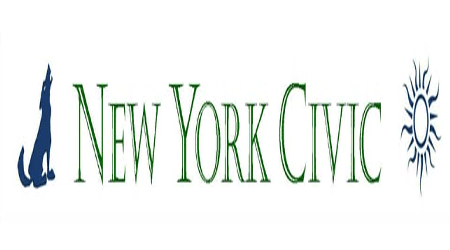 Today, on a glorious summer morning, the city opened the new McCarren Pool and Play Center, a multi-purpose recreational area whose centerpiece is McCarren Pool, one of the eleven Robert Moses built in 1936 as commissioner of the city Parks Department with federal funds provided as part of President Franklin D. Roosevelt’s efforts to fight the Great Depression.
Today, on a glorious summer morning, the city opened the new McCarren Pool and Play Center, a multi-purpose recreational area whose centerpiece is McCarren Pool, one of the eleven Robert Moses built in 1936 as commissioner of the city Parks Department with federal funds provided as part of President Franklin D. Roosevelt’s efforts to fight the Great Depression.
Mayor Bloomberg presided at the ceremony, held on the pool deck, which concluded with hundreds of neighborhood youth jumping into the water. They could not dive, because the water is four feet deep, but the cooling effect of the water on a hot summer day provided equal pleasure, as well as safety, which is Rule One of the Rules of the Pools.
Today’s opening completed a project which was the Parks equivalent of the Second Avenue Subway Line. The pool closed in 1984 because of mechanical failures which became impractical to repair. For twenty-eight years the pool remained drained although in 2005 cultural programs made use of the empty pool.
There were a number of reasons for this unfortunate situation. For one thing, pool attendance declined after the 1930s. When the pools were built, apartments were not air conditioned. Vast numbers of people simply used the pools to escape the stifling heat of summer. Tenements were not built to provide multiple exposures to airflows from different directions. Automobiles, which city dwellers could use to drive to the country where the weather was cooler, were not used as widely as they were in later years. For many New Yorkers, the public pool was the only refuge from summer’s heat. Tens of thousands of people often filled the pools, some of which were larger than football fields. As lifestyles changed and alternate methods of cooling were developed, the crowds got smaller. Nonetheless, the pools were important neighborhood recreational facilities.
Most buildings wear out over a period of time, and the pools were no exception. Iron rusted, pipes became clogged, and maintenance became more difficult and costly. After World War II, the pools increasingly needed more intensive care in order to keep operating safely.
The city, mindful of its huge investment, sought to rehabilitate the pools. Of the eleven Moses pools, eight received this treatment, some during the Koch administration.
The outlier, the pool that was not modernized, was the McCarren pool in Williamsburg, which is in northwest Brooklyn. The reason for that is that there was community opposition to the rehab proposals. The Williamsburg neighborhood adjoins Bedford-Stuyvesant, and there was concern that teenagers from an area with a higher crime rate would threaten the local boys. Some of the objectors simply did not want outsiders, or anyone who looked different, in their territory.
Another factor was that, because of population shifts and changing recreational preferences, the McCarren pool was considered too large for the community’s needs, and some locals feared that less desirable uses might be moved to the pool.
Although no majority ever rejected the pool, the dispute caused the elected officials to spend the pool rehabilitation money at other Brooklyn facilities. The window of opportunity closed when the city plunged into the fiscal crisis of 1975. Meanwhile, construction costs escalated and the money set aside was no longer sufficient to rehabilitate the pool. Time passed.
There were a number of neighborhood groups organized to support reconstruction of the pool, while some opposed it or were indifferent. What broke the ice was the proposed landmarking of the Moses pools. Although there were eleven of them and many were relatively similar, the pools were turning 70 years old and became regarded by some as classic examples of period architecture. In the end, the intervention of landmarks people and cultural sponsors helped to create the critical mass that led Mayor Bloomberg to act.
Credit belongs to Mayor Bloomberg, because the city’s capital budget was used to pay for the construction. He was not afraid to spend large sums on this project, although ten earlier pools were able to be rehabilitated for sums in the neighborhood of ten million, this one cost 48. It did have several amenities and features absent in the earlier building plans.
Another change was the gentrification of Greenpoint and Williamsburg. When these old Brooklyn neighborhoods began to attract young professional couples, they became more attractive sites for substantial public expenditures.
In the end, the prolonged delays may have resulted in a better pool and recreation center. They also provide a case history of the vicissitudes of a public issue which occupied Williamsburg and its citizens for many years.
Today’s ceremony marks a major milestone in the resolution of an important public issue. The future will tell us whether the Rec Center justifies its cost; whether it does or not, the Center will gain satisfied users, adults and children, who will help support it. Hopefully, the building will strengthen the fabric of a fast changing Williamsburg. A happy ending for the decision making process.
P.S. There are many dedicated people who devoted considerable time and effort to this project who deserve recognition for what they have done. I don’t know who all of them are, but the community should compile a list and appropriately record those people who helped make this day possible.
McCarren Pool is located on Lorimer Street between Bayard Street and Driggs Avenue. It is accessible by subway via the G train to Nassua Ave and by bus via the B48, B43 and B62.
To post a comment on this article for us to publish, click here.

